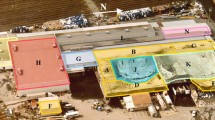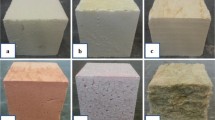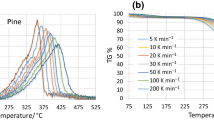Abstract
Wildland firebrands are known to ignite materials in attic spaces of homes. To clarify the effects of choices in attic insulation materials for homes located at the wildland urban interface, this study seeks to characterize the effects of firebrand characteristics on the ignition propensity of several common insulation materials: polyurethane foam, expanded polystyrene (EPS), extruded polystyrene (XPS), flame retarded and non-flame retarded denim, and flame retarded and non-flame retarded loosefill cellulose. An experimental system was developed to explore the effects of firebrand heating, air flow, and firebrand configuration on ignition. For an equal initial mass of wooden material, two firebrand configurations were generated: a single whole firebrand and multiple (five) fragmented firebrands. Relative to whole firebrands, the fragmented firebrands were found to more reliably ignite the insulation materials. Thermoplastic insulation material would only ignite in a temporary flash flame, but did not support sustained burning. Following the flash flame, the firebrands would melt through the synthetic polymer material (XPS and EPS) and cease smoldering. Cellulosic insulation materials would ignite in a sustained fire provided that there was adequate air flow. A simple heat and mass transfer model was developed to describe the ignition process due to firebrand deposition. Traditional lab-scale experiments, thermogravimetric analysis and cone calorimetry, were performed to parameterize the model. Results followed experimentally observed firebrand temperature patterns. There was an average error of approximately 8.5% between firebrand temperature model predictions and experimental measurements. Also, consistent with the experimental results, the model predicted that increasing air flow increased ember temperature and reduced the time to ignition for cases in which ignition occurs.















Similar content being viewed by others
References
Martinuzzi S, Stewart SI, Helmers DP, Mockrin MH, Hammer RB, Radeloff VC (2015) The 2010 wildland-urban interface of the conterminous united states. Research Map NRS-8. US Department of Agriculture, Forest Service, Northern Research Station, Newtown Square, PA. 124 pp [includes pull-out map], 8:1–124
Caton SE, Hakes RSP, Gorham DJ, Zhou A, Gollner MJ (2017) Review of pathways for building fire spread in the wildland urban interface part i: exposure conditions. Fire Technol 53(2):429–473. https://doi.org/10.1007/s10694-016-0589-z.
Manzello SL, Shields JR, Yang JC, Hayashi Y, Nii D (2007) On the use of a firebrand generator to investigate the ignition of structures in wildland–urban interface (WUI) fires. In: 11th International conference on fire science and engineering (INTERFLAM), pp 3–5
Long AJ, Randall CK (2004) Wildfire risk assessment guide for homeowners in the southern United States. School of Forest Resources and Conservation, University of Florida
Quarles SL, Valachovic Y, Nakamura GM, Nader GA, De Lasaux MJ (2010) Home survival in wildfire-prone areas: building materials and design considerations. ANR Publication, p 8393
Quarles S, Sindelar M et al (2011) Wildfire ignition resistant home design (WIRHD) program: full-scale testing and demonstration final report. Technical report, USDA Forest Service-Savannah River, New Ellenton, SC
Wang S, Huang X, Chen H, Liu N, Rein G (2015) Ignition of low-density expandable polystyrene foam by a hot particle. Combust Flame 162(11):4112–4118
Hadden RM, Scott S, Lautenberger C, Fernandez-Pello AC (2011) Ignition of combustible fuel beds by hot particles: an experimental and theoretical study. Fire Technol 47(2):341–355
Urban JL, Zak CD, Fernandez-Pello C (2018) Spot fire ignition of natural fuels by hot aluminum particles. Fire Technol. 54(3):797–808
Wang S, Huang X, Chen H, Liu N (2017) Interaction between flaming and smouldering in hot-particle ignition of forest fuels and effects of moisture and wind. Int J Wildland Fire 26(1):71–81
Manzello SL, Cleary TG, Shields JR, Maranghides A, Mell W, Yang JC (2008) Experimental investigation of firebrands: generation and ignition of fuel beds. Fire Saf J 43(3):226–233
Ganteaume A, Lampin-Maillet C, Guijarro M, Hernando C, Jappiot M, Fonturbel T, Pérez-Gorostiaga P, Vega JA (2010) Spot fires: fuel bed flammability and capability of firebrands to ignite fuel beds. Int J Wildland Fire 18 (8):951–969
Warey A (2018) Influence of thermal contact on heat transfer from glowing firebrands. Case Stud Therm Eng 12:301–311. https://doi.org/10.1016/j.csite.2018.04.018
Yin P, Liu N, Chen H, Lozano JS, Shan Y (2014) New correlation between ignition time and moisture content for pine needles attacked by firebrands. Fire Technol 50(1):79–91
Gol’dshleger UI, Pribytkova KV, Barzykin VV (1973) Ignition of a condensed explosive by a hot object of finite dimensions. Combust Explos Shock Waves 9(1):99–102
Jones JC (1993) Predictive calculations of the effect of an accidental heat source on a bed of forest litter. J Fire Sci 11(1):80–86
Jones JC (1995) Improved calculations concerning the ignition of forest litter by hot particle ingress. J Fire Sci 13(5):350–356
Babrauskas V (2003) Ignition handbook. Fire Science Publishers, Issaquah, WA. ISBN: 0972811133
Lautenberger C, Fernandez-Pello AC (2009) Spotting ignition of fuel beds by firebrands. WIT Trans Model Simul 48:603–612
Manzello SL, Maranghides A, Shields JR, Mell WE, Hayashi Y, Nii D (2007) Measurement of firebrand production and heat release rate (HRR) from burning Korean pine trees. Fire Saf Sci 7:108–108
El Houssami M, Mueller E, Filkov A, Thomas JC, Skowronski N, Gallagher MR, Clark K, Kremens R, Simeoni A (2016) Experimental procedures characterising firebrand generation in wildland fires. Fire Technol 52(3):731–751
International Code Council (2018) International residential code for one-and two-family dwellings. International Code Council
Damant GH, Williams SS, McCormack JA (1983) The role of fabric in the cigarette ignition of upholstered furniture. J Fire Sci 1(5):309–321
Zak CD (2015) The effect of particle properties on hot particle spot fire ignition. University of California, Berkeley
Persoons T, McGuinn A, Murray DB (2011) A general correlation for the stagnation point Nusselt number of an axisymmetric impinging synthetic jet. Int J Heat Mass Transf 54(17):3900–3908. https://doi.org/10.1016/j.ijheatmasstransfer.2011.04.037
Bergman TL, Incropera FP, DeWitt DP, Lavine AS (2011) Fundamentals of heat and mass transfer. Wiley, New York
Drysdale D (2011) An introduction to fire dynamics. Wiley, New York
Bamford CH, Crank J, Malan DH (1946) The combustion of wood. Part I. In: Mathematical proceedings of the Cambridge Philosophical Society, vol 42, pp 166–182. Cambridge University Press
Drysdale DD, Thomson HE (1989) Flammability of plastics ii: critical mass flux at the firepoint. Fire Saf J 14(3):179–188. https://doi.org/10.1016/0379-7112(89)90071-4
Tsai T-H, Li M-J, Shih I-Y, Jih R, Wong S-C (2001) Experimental and numerical study of autoignition and pilot ignition of PMMA plates in a cone calorimeter. Combust Flame 124(3):466–480
Gani A, Naruse I (2007) Effect of cellulose and lignin content on pyrolysis and combustion characteristics for several types of biomass. Renew Energy 32(4):649–661. https://doi.org/10.1016/j.renene.2006.02.017
Nassar MM, Ashour EA, Wahid SS (1996) Thermal characteristics of bagasse. J Appl Polym Sci 61(6): 885–890
Munir S, Daood SS, Nimmo W, Cunliffe AM, Gibbs BM (2009) Thermal analysis and devolatilization kinetics of cotton stalk, sugar cane bagasse and shea meal under nitrogen and air atmospheres. Bioresour Technol 100(3):1413–1418
Wang Q, Li J, Winandy JE (2004) Chemical mechanism of fire retardance of boric acid on wood. Wood Sci Technol 38(5): 375–389
Mostashari SM, Mostashari SZ (2008) Combustion pathway of cotton fabrics treated by ammonium sulfate as a flame-retardant studied by TG. J Therm Anal Calorim 91 (2):437–441
Roberts BC (2017) Fire safety in sustainable buildings: status, options, alternatives. The University of California at Austin, Austin
Bakhtiyari S, Taghi-Akbari L, Barikani M (2010) The effective parameters for reaction-to-fire properties of expanded polystyrene foams in bench scale. Iran Polym J 19:27–37
Irvine DJ, McCluskey JA, Robinson IM (2000) Fire hazards and some common polymers. Polym Degrad Stab 67(3):383–396
Usta N (2012) Investigation of fire behavior of rigid polyurethane foams containing fly ash and intumescent flame retardant by using a cone calorimeter. J Appl Polym Sci 124(4):3372–3382. https://doi.org/10.1002/app.35352.
White RH, Nam S, Parikh DV (2013) Cone calorimeter evaluation of two flame retardant cotton fabrics. Fire Mater 37(1):46–57
Dlugogorski BZ, Hirunpraditkoon S, Kennedy EM (2014) Ignition temperature and surface emissivity of heterogeneous loosely packed materials from pyrometric measurements. Fire Saf Sci 11:262–275
Dorez G, Ferry L, Sonnier R, Taguet A, Lopez-Cuesta J-M (2014) Effect of cellulose, hemicellulose and lignin contents on pyrolysis and combustion of natural fibers. J Anal Appl Pyrol 107:323–331. https://doi.org/10.1016/j.jaap.2014.03.017
Schartel B, Hull TR (2007) Development of fire-retarded materials–interpretation of cone calorimeter data. Fire Mater 31(5):327–354
Schartel B, Bartholmai M, Knoll U (2005) Some comments on the use of cone calorimeter data. Polym Degrad Stab 88(3):540–547
An W, Jiang L, Sun J, Liew KM (2015) Correlation analysis of sample thickness, heat flux, and cone calorimetry test data of polystyrene foam. J Therm Anal Calorim 119(1):229–238
Acknowledgements
Funding was provided by the Department of Commerce through NIST (Grant no. 60NANB16D278) and by the Department of Interior through the Joint Fire Science Program under Project JFSP 15-1-04-4.
Author information
Authors and Affiliations
Corresponding author
Additional information
Publisher's Note
Springer Nature remains neutral with regard to jurisdictional claims in published maps and institutional affiliations.
Rights and permissions
About this article
Cite this article
Wessies, S.S., Chang, M.K., Marr, K.C. et al. Experimental and Analytical Characterization of Firebrand Ignition of Home Insulation Materials. Fire Technol 55, 1027–1056 (2019). https://doi.org/10.1007/s10694-019-00818-8
Received:
Accepted:
Published:
Issue Date:
DOI: https://doi.org/10.1007/s10694-019-00818-8




